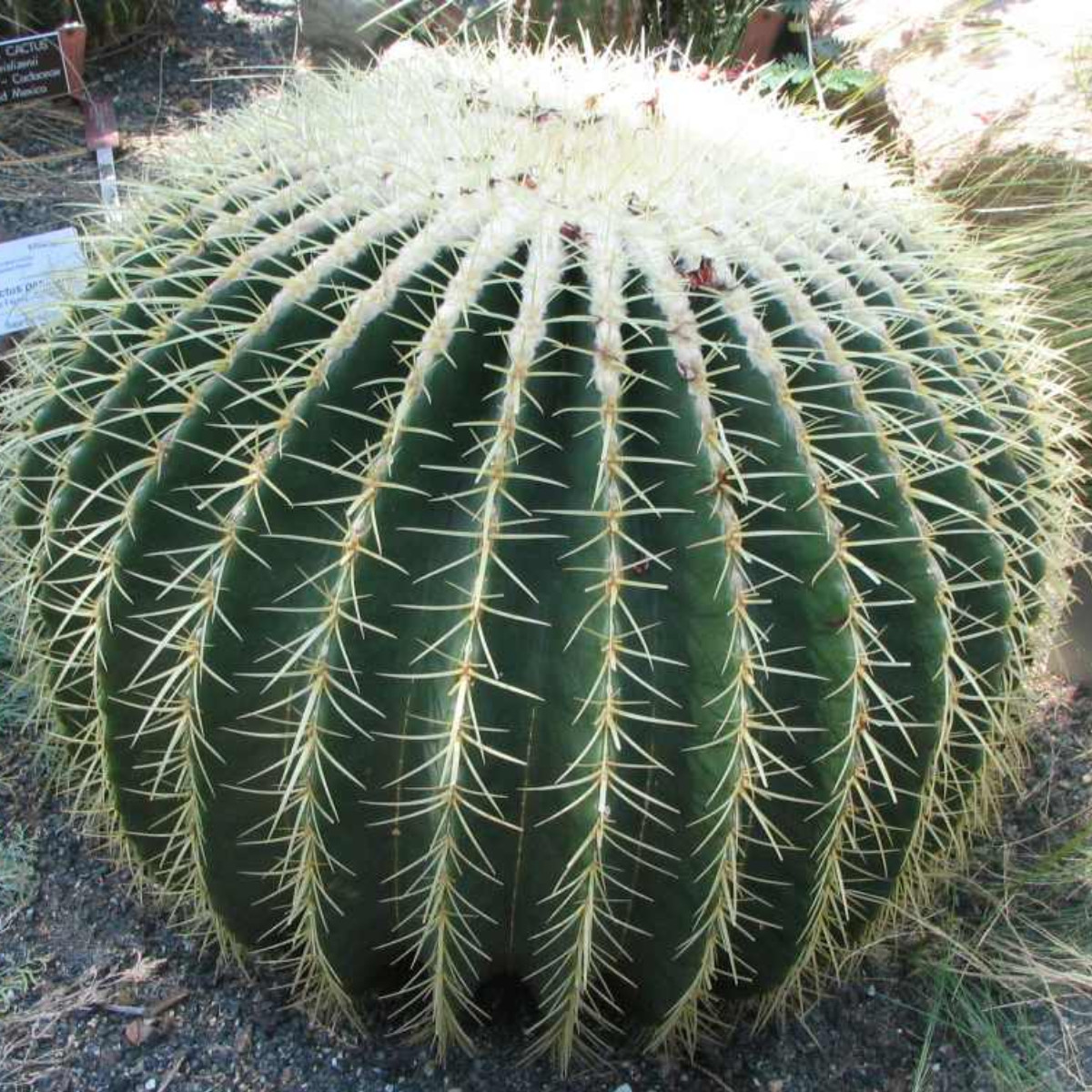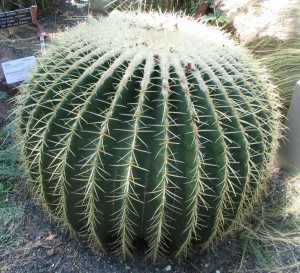Common Names: Mother-in-Laws Chair, Golden Barrel Cactus, Golden Ball
Family: Cactaceae
Distribution and habitat: Echinocactus grusonii is a well known species of cactus endemic to east-central Mexico. It is rare and critically endangered species in the wild. The cactus grows in volcanic rock on slopes at altitudes around 1,400 metres (4,600 ft).
Growing as a large roughly spherical globe, Echinocactus grusonii may eventually reach over 1 metre (3.3 ft) in height after many years. The generation lifetime is estimated to be 30 years.
Description: Echinocactus grusonii will have probably a diameter of 5-8cm (2-3 inch) as a four-year-old seedling. The rate of growth slows down with the age, however, and it will take 15 or 20 years for the plant to add another 15-28cm (6-11 inch) to its girth. Very young specimens are covered with tubercles (wart-like swellings). As Echinocactus grusonii grows, the tubercles gradually become lined up in vertical rows and less conspicuous. By the time a plant is 15cm (6 inch) across, the tubercles will have merged, forming 20 to 27 narrow ribs separated by deep indentations. Areoles closely set along the ribs are filled with yellowish or whitish woolly hairs. The areoles at the top of the plant are so numerous that the crown of the ball appears covered in wool. The characteristic golden spines of the species also rise from the areoles. From 5 to 10 of the spines are 1cm (0.4 inch) or more long and another 3 to 5 of them may be twice as long.
Bright yellow, cup-shaped, 5cm (2 inch) wide flowers eventually appear from areoles on the crown of mature plants, but because Echinocactus grusonii does not bloom until fully mature, the flowers are never seen in room size specimens. In areas with mild winter temperatures, however, this Echinocactus grusonii can be successfully grown outdoors and in good conditions may ultimately become old and big enough to produce flowers in summer.
Houseplant care: Plant has spines or sharp edges; use extreme caution when handling.
Light: Echinocactus grusonii need to be given direct sunlight throughout the year in order to produce long and well coloured spines.
Temperature: During the active growth period normally warm room temperatures are suitable. Indoor Echinocactus grusonii should be given a winter rest period, ideally at about 10C (50C). The minimum tolerable temperature is about 5C (41C). At lower temperatures the surface of the plant may become discoloured by the appearance of distinguishing brown spots. On the other hand, if indoor winter temperatures rise much above 12C (70C), the plant will be encouraged to continue growing and with often inadequate light of short winter days, the nearly spherical shape may elongate in a rather unsightly way.
Water: During the active growth period water moderately, enough to make the potting mixture moist throughout and allowing the top centimetre (0.4 inch) or so of the potting mixture to dry out before watering again. During the winter rest period water much more sparingly, giving only enough to keep the potting mixture from drying out completely. Too much moisture inevitably causes rotting to occur at the base of a resting Echinocactus grusonii.
Fertilising: Rather than providing regular applications of a liquid fertiliser, it is a better idea to incorporate a long term slow release fertiliser in the potting mixture.
Potting and repotting: Either soil based or peat based potting mixture is suitable, but make it more porous by the addition of a one-third portion of coarse sand. Plants about 8cm (3 inch) across can be accommodated for some years in pots. Remove an Echinocactus grusonii from its pot every spring to see whether it needs moving on. If it has grown so much that the roots fill the pot, move the plant into a pot one size larger. Otherwise, gently shake the old potting mixture from the roots and carefully replace the plant in the original pot after it has been thoroughly cleaned adding fresh potting mixture to the roots. After repotting, do not water for a week or more.
Gardening: Echinocactus grusonii are summer-growing and pretty easy plants to cultivate.
Light frost protection required for safe cultivation, but can tolerate sporadic light frost. Echinocactus grusonii are hardy to about -8C (15F) for brief periods.
Position: Outside they need a bright exposure, full sun or half shade in summer if the location is exceedingly hot or bright.
It can tolerate moderate shade. A plant that has been growing in shade should be slowly hardened off before placing it in full sun as the plant will be severely scorched if moved too suddenly from shade into sun.
Soil: They are suited for any rich, well drained soil such as clay, pumice, lava grit and only a little addition of peat or leaf-mould.
Water: Water regularly during the summer growth cycle (this plant need plenty of water, but do not overwater and let their soil dry out between waterings). Avoid wetting the body of this plant while it is in sunlight. A wet cactus in the sun light can cause sun burning which can lead to scares or even fungal infections and death. Keep theEchinocactus grusonii rather dry in winter. No water should ever be allowed to stand around the roots.
Fertilising: Feed with a high potassium fertilizer in summer.
Propagation: Potted Echinocactus grusonii can be propagated only from seed. Seedling can be raised easily. In their first few years they grow rapidly.
Sow the tiny seed of Echinocactus grusonii in trays filled with equal parts of peat moss and coarse sand potting mixture. Place then the trays in filtered sun, cover with a glass sheet and keep the soil moist until the seeds germinate in approximately 2 to 6 weeks. They will look like small spheres, red in colour, not green. Then gradually remove the glass cover. When the small cacti start to sprout tiny spines, use a pair of tweezers to transfer them from the propagation trays into 5cm (2 inch) pots filled with the same soil mix used in the germination trays. Allow the small cacti to grow for about one-two year and then move the cacti to 10cm (4 inch) pots and treat them as mature Echinocactus grusonii.
Problems: The most dangerous things for Echinocactus grusonii plants are: hypothermia of the ground clod; the lack of light; waterlogging of the soil, especially in the winter season, which leads to rotting.
Watch for infestations of mealybug, scale insects and spider mite.
Treatment: Use an appropriate pesticide to treat the plant.
Notes: The very young specimens ofEchinocactus grusonii look much like cacti of the genus Mammillaria, with which they are sometimes confused.
Uses: Echinocactus grusonii is widely cultivated by specialty plant nurseries as an ornamental plant, for planting in containers, desert habitat gardens, rock gardens and in conservatories.
Unlike many plants, the Echinocactus grusonii get more and more beautiful as they grow. As old specimens they can be truly majestic. They are best planted close together among large rocks or boulders.
Being a drought-tolerantEchinocactus grusonii is suitable for xeriscaping
SUMMARY:
CHARACTERISTICS:
Foliage green
Shape globular
Height: 60-90cm (24-36 inch)
PROPER CARE:
Watering in rest period sparingly
Watering in active growth period moderately
Light direct
Temperature in rest period min 4C max 10C (39-50F)
Temperature in active growth period min 16C max 24C (61-75F)
Humidity low
Hardiness zone: 9a-11
Begonia propagation f...
Essential Nutrients f...
Portulacaria afra
Tillandsia recurvata
Tillandsia stricta
Columnea microphylla
Clivia miniata
Cleyera japonica
Clerodendrum thomsoni...
Cleistocactus strausi...



